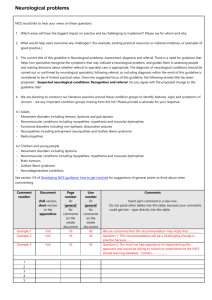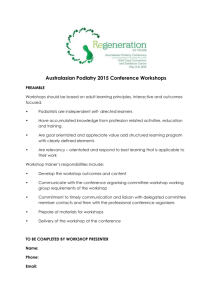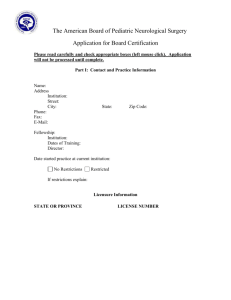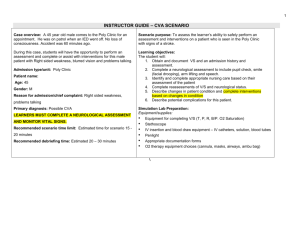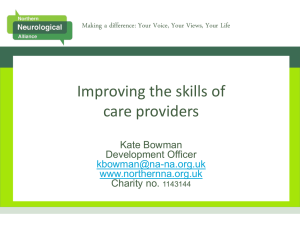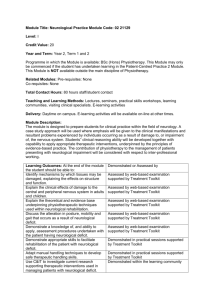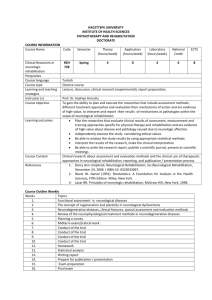Neurology Clerkship Clinical Evaluation Students will be assigned a
advertisement
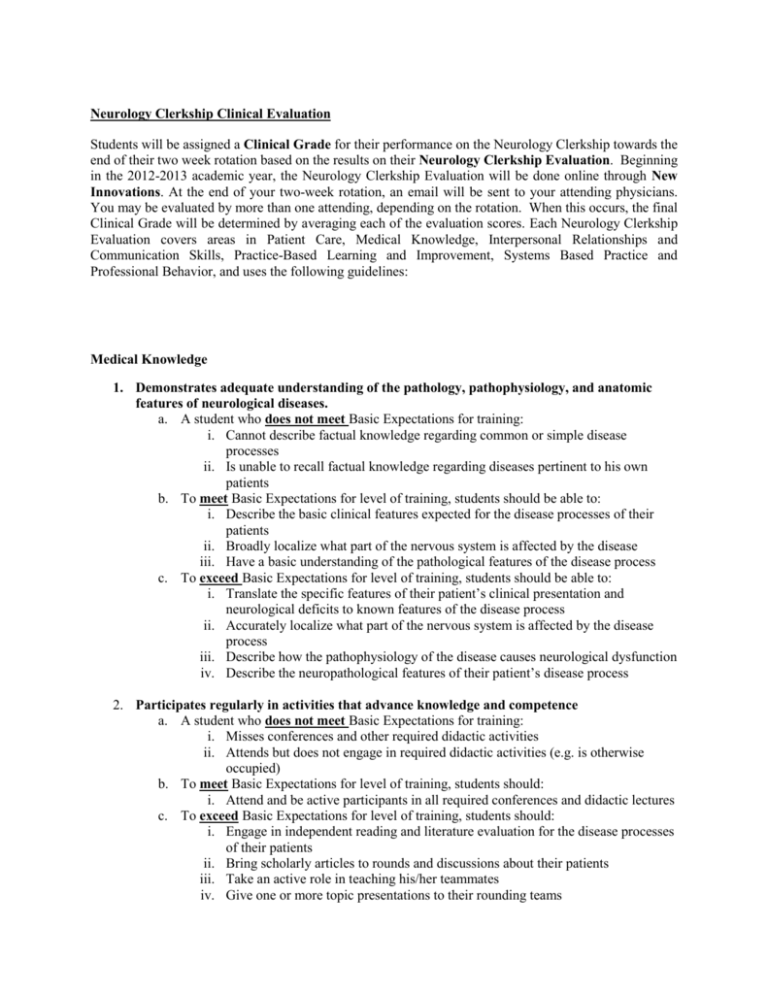
Neurology Clerkship Clinical Evaluation Students will be assigned a Clinical Grade for their performance on the Neurology Clerkship towards the end of their two week rotation based on the results on their Neurology Clerkship Evaluation. Beginning in the 2012-2013 academic year, the Neurology Clerkship Evaluation will be done online through New Innovations. At the end of your two-week rotation, an email will be sent to your attending physicians. You may be evaluated by more than one attending, depending on the rotation. When this occurs, the final Clinical Grade will be determined by averaging each of the evaluation scores. Each Neurology Clerkship Evaluation covers areas in Patient Care, Medical Knowledge, Interpersonal Relationships and Communication Skills, Practice-Based Learning and Improvement, Systems Based Practice and Professional Behavior, and uses the following guidelines: Medical Knowledge 1. Demonstrates adequate understanding of the pathology, pathophysiology, and anatomic features of neurological diseases. a. A student who does not meet Basic Expectations for training: i. Cannot describe factual knowledge regarding common or simple disease processes ii. Is unable to recall factual knowledge regarding diseases pertinent to his own patients b. To meet Basic Expectations for level of training, students should be able to: i. Describe the basic clinical features expected for the disease processes of their patients ii. Broadly localize what part of the nervous system is affected by the disease iii. Have a basic understanding of the pathological features of the disease process c. To exceed Basic Expectations for level of training, students should be able to: i. Translate the specific features of their patient’s clinical presentation and neurological deficits to known features of the disease process ii. Accurately localize what part of the nervous system is affected by the disease process iii. Describe how the pathophysiology of the disease causes neurological dysfunction iv. Describe the neuropathological features of their patient’s disease process 2. Participates regularly in activities that advance knowledge and competence a. A student who does not meet Basic Expectations for training: i. Misses conferences and other required didactic activities ii. Attends but does not engage in required didactic activities (e.g. is otherwise occupied) b. To meet Basic Expectations for level of training, students should: i. Attend and be active participants in all required conferences and didactic lectures c. To exceed Basic Expectations for level of training, students should: i. Engage in independent reading and literature evaluation for the disease processes of their patients ii. Bring scholarly articles to rounds and discussions about their patients iii. Take an active role in teaching his/her teammates iv. Give one or more topic presentations to their rounding teams Patient Care 1. Takes a pertinent and thorough Neurological History containing information which provides some degree of neurological localization and allows for an understanding of the chronology and severity of the disease process. a. A student who does not meet Basic Expectations for training: i. Fails to ask basic components of the history, such as the chief complaint, time course of symptoms, past medical/surgical history, medications, and allergies ii. Is unable to organize basic data from the History of Present Illness in a coherent fashion b. To meet Basic Expectations for level of training, the student’s history should: i. Contain the patient’s chief complaint and as well as a basic history of present illness ii. Include the clinical features of the patient’s neurological deficits iii. Include the onset and time course of the neurological deficits iv. Allow for a rough general localization of the disease process within the nervous system c. To exceed Basic Expectations for level of training, the student’s history should: i. Contain a history of present illness that is expansive for the details of the patient’s neurological symptoms ii. Include a neurological review of systems that includes both positive and pertinent negative features iii. Contain information about the functional disability the patient is experiencing due to their neurological deficits iv. Allow for precise localization of the disease process within the nervous system 2. The history contains accurate medication dosages, formulations and drug allergies a. A student who does not meet Basic Expectations for training: i. Fails to list medications or does not know the dosages of the patient’s medications b. To meet Basic Expectations for level of training, the student’s history should: i. Include all medications the patient is taking ii. Include a list of all medications causing prior allergic reactions c. To exceed Basic Expectations for level of training, the student’s history should: i. Include a list of all medications and their respective dosages that the patient is taking including OTC medications ii. Elucidate any side effects from the current medications that the patient is taking iii. Include a list of all medications causing prior allergic reactions or adverse tolerance reactions 3. Is able to demonstrate a thorough Neurological Examination that contains pertinent aspects from each of the 6 realms of the neurological exam and contains enough detail to localize the disease process. a. A student who does not meet Basic Expectations for training: i. Consistently fails to include pertinent components of the neurological examination necessary to provide localization and quantification of their patient’s deficits ii. Is unable to adequately perform basic components of the neurological examination (such as examining pupillary function, eliciting DTR’s, evaluating gait, etc) b. To meet Basic Expectations for level of training, the student’s Neurological Exam should: i. Mention enough details to include at least a screening evaluation for mental status, cranial nerves, motor , sensory, coordination, and gait (or whatever is appropriate for their patient) ii. Be able to properly demonstrate neurological deficits in their patients iii. Allow the student to generally localize neurological deficits c. To exceed Basic Expectations for level of training, the student’s Neurological Exam should: i. Include a basic screening neurological examination covering mental status, cranial nerves, motor, coordination, sensory and gait (or whatever is appropriate for their patient) ii. Allow the student to accurately localize neurological deficits iii. Include as well an expanded neurological exam that quantifies the severity of the deficits 4. Generates a pertinent Differential Diagnosis that takes into account disease localization and prioritizes the most likely diagnosis a. A student who does not meet Basic Expectations for training: i. Is unable to formulate a potential list of plausible diagnoses for simple complaints ii. Is unable to use discriminating features of the disease process (e.g. acute vs. chronic) to determine likely disease processes b. To meet Basic Expectations for level of training, the student’s Differential Diagnosis should: i. List neurological disorders that occur within the broad localized region of the nervous system where their patient’s neurological deficits exist ii. Include the most likely disease processes based on the history and physical examination findings c. To exceed Basic Expectations for level of training, the student’s Differential Diagnosis should: i. Apply localization based on both the neurological examination and on historical features of the disease process ii. Take into account the onset and time course and severity of the disease process iii. Take into account the patient’s past medical, surgical and medication use histories iv. Prioritize common disorders which are most likely to cause the patient’s disease process as well as those disorders considered to be neurological emergencies 5. Develops an appropriate Diagnostic Plan specific to the unique aspects and needs of their patients a. A student who does not meet Basic Expectations for training: i. Is unable to explain the rationale for tests that are ordered ii. Orders a long list of tests that are not pertinent to the differential diagnosis or management of the patient’s illness b. To meet Basic Expectations for level of training, the Diagnostic Plan should include investigations that: i. Pertain to those diagnoses entertained within their Differential Diagnosis ii. Are justifiable with results that will alter the diagnosis or management of the disease process and not be obtained “just to get a baseline” iii. The results of which can be interpreted correctly by the student as they pertain to their patient c. To exceed Basic Expectations for level of training, the Diagnostic Plan should include investigations that: i. Pertain to the most likely diagnoses within their Differential Diagnosis ii. The student is able to connect to the pathophysiology of the disease process iii. Are justified by the patient’s clinical presentation and do not include superfluous investigations that are likely to be normal or not directly affect patient care 6. Develops an appropriate Treatment Plan specific to their patient’s illness a. A student who does not meet Basic Expectations for training: i. Fails to develop a basic plan for treatment based on the patient’s condition ii. Does not understand the rationale for their patients’ treatment plans b. To meet Basic Expectations for level of training, the Treatment Plan should: i. Positively affect the outcome of the patient’s disease process ii. Include interventions that are cost effective for the patient iii. Be understood by the student as to the expected benefits and risks associated with the treatment c. To exceed Basic Expectations for level of training, the Treatment Plan should: i. Be understood by the student and justified by available literature or standard of care arguments ii. Include alternative options for treatment that can be weighed against one another with regards to cost, benefits and risks iii. Include appropriate monitoring and follow up for the patient to assess risks and benefits 7. Provides effective care with respect to the patient’s psychosocial level of functioning and their cultural beliefs a. A student who does not meet Basic Expectations for training: i. Is insensitive to or does not accept the cultures or backgrounds of patients ii. Fails to consider a patient’s cultural beliefs when providing care b. To meet Basic Expectations for level of training, Care Plans should: i. Include treatment options that individuals will most likely be able to comply with based on cultural or religious beliefs ii. Be sensitive to the patient’s culture, sexual orientation and religious belief system c. To exceed Basic Expectations for level of training, Care Plans should: i. Include treatment options that consider medical compliance (eg. frequency of treatments, need for follow up, etc) as well as the patient’s ability to pay for the prescribed treatments ii. Be explained to the patient in a way that is commensurate with the patient’s level of medical sophistication and understanding iii. Allow patients to question the treatment plan and provide answers to those questions Interpersonal Relationships and Communication 1. Clearly and accurately presents patients findings to team members a. A student who does not meet Basic Expectations for training: i. Is frequently unaware of pertinent aspects of their patients’ diagnostic workup ii. Is frequently unaware of their patient’s current clinical status b. To meet Basic Expectations for level of training, students should: i. Have a thorough understanding of their patients’ current clinical status ii. Be able to provide the results of all diagnostic testing obtained on their patients to the treating team iii. Be able to provide details of their patients’ neurological examinations c. To exceed Basic Expectations for level of training, students should: i. Be organized in presenting patient findings, pointing out pertinent abnormal and normal results from diagnostic evaluations ii. Present their patients’ neurological examination and deficits in a systemic and quantitative fashion 2. Maintains clear, complete, accurate, timely and legible medical records a. A student who does not meet Basic Expectations for training: i. Does not complete daily notes within the time frame set forth by expectations ii. Does not address the patient’s primary problem on the medical record iii. Does not follow the expected order of providing information on the medical record (e.g. SOAP note, etc) iv. Provides inaccurate details of their patient’s clinical findings or diagnostic workup. v. Provides inaccurate information concerning their patient’s care (diagnostic studies, vitals, examination findings, medications and dosages) on the medical record b. To meet Basic Expectations for level of training, student progress notes should: i. Contain a daily general and neurological examination on each patient being followed ii. Contain the results of diagnostic evaluations and current medications iii. Consist of legible writing c. To exceed Basic Expectations for level of training, student progress notes should: i. Accurately define and quantify neurological deficits found in their patients ii. List and interpret results of diagnostic evaluations for their patients iii. Suggest treatment plans and further diagnostic evaluations for their patients 3. Shows empathy and respect to patients and their families a. A student who does not meet Basic Expectations for training: i. Demonstrates insensitivity or rudeness when speaking to a patient or a family ii. Openly shows bias or prejudice against a patient or family iii. Ignores or minimizes a patient’s or family’s concerns b. To meet Basic Expectations for level of training, students should: i. Acknowledge their patients’ concerns regarding their treatment ii. Demonstrates sensitivity and courtesy when speaking to a patient or family c. To exceed Basic Expectations for level of training, students should: i. Directly communicate treatment plans to patients and their families ii. Be available to directly answer their patients’ questions in an empathetic way iii. Demonstrate an understanding for the burden that their patients’ disease process plays in their personal lives and seeks to alleviate that burden Practice Based Learning and Improvement 1. Uses evidence from practice guidelines and scientific studies to develop appropriate diagnostic and treatment plans a. A student who does not meet Basic Expectations for training: i. Is unable to identify potential sources of information regarding patient care ii. Is unable to identify gaps in one’s own knowledge in order to guide further inquiry b. To meet basic expectations for level of training, students should: i. Can identify and search potential sources of reliable information (such as “Up to Date”, “E-Medicine”, “MD Consult” etc.) regarding their patients’ conditions and treatment plans when directed to do so ii. Identifies gaps in one’s own knowledge in order to guide further inquiry c. To exceed basic expectations for level of training, students should: i. Refer to diagnostic and treatment guidelines contained within practice parameters or pivotal studies when developing plans of care without being directed to do so ii. Is able to identify characteristics of studies and guidelines that suggest reliability or a lack of applicability to their patients 2. Shows an eagerness to learn, identifying their own questions and reviewing the literature concerning their patients’ illness a. A student who does not meet Basic Expectations for training: i. Does not read about their own patient’s conditions ii. Is not concerned with their own lack of knowledge concerning their patients’ conditions b. To meet basic expectations for level of training, students should: i. Read background information (e.g. textbooks or review articles contained within “MD Consult”, “E-Medicine”, “Up-to –Date”) about their patient’s conditions ii. Identifies questions that need to be answered before determining a plan of care c. To exceed basic expectations for level of training, students should: i. Use their own initiatives including background (e.g. textbook and review articles) and foreground (e.g. evidence-based literature, pivotal trial articles, and guidelines) to review the relevant literature concerning their patients’ disease processes ii. Develop their own independent questions about the care of their patients to guide reading and literature searches iii. Spontaneously share what they have discovered during rounds or clinic patient presentations
